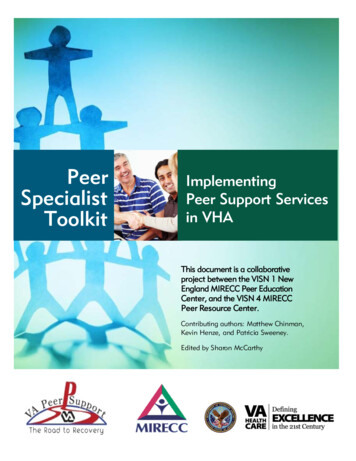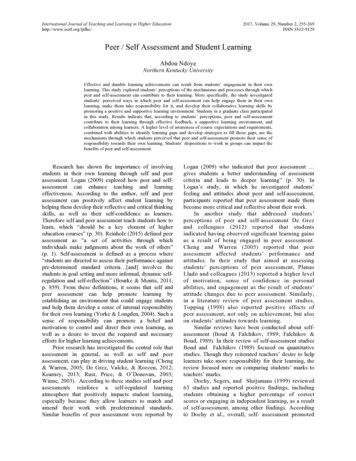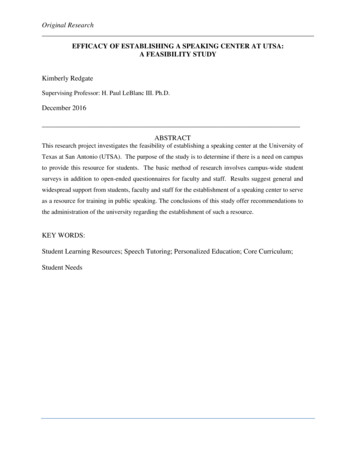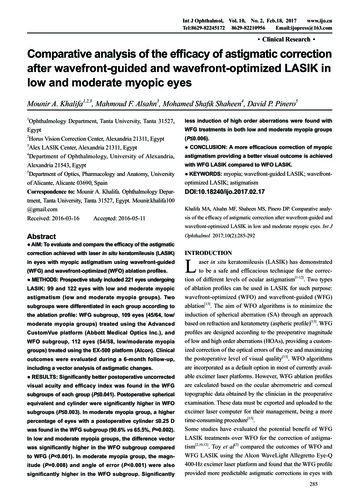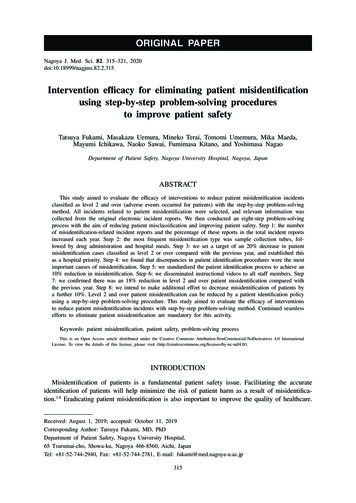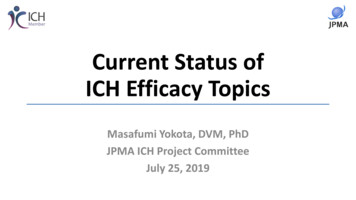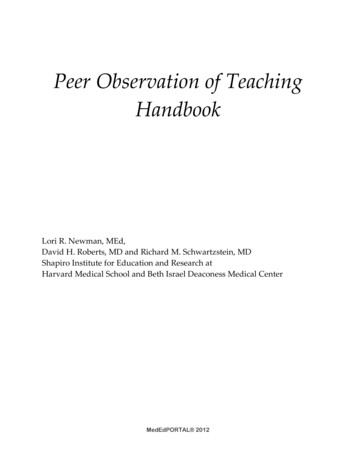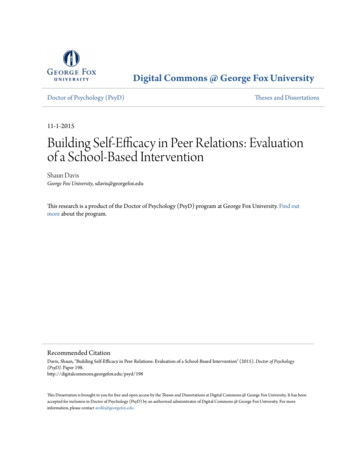
Transcription
Digital Commons @ George Fox UniversityDoctor of Psychology (PsyD)Theses and Dissertations11-1-2015Building Self-Efficacy in Peer Relations: Evaluationof a School-Based InterventionShaun DavisGeorge Fox University, sdavis@georgefox.eduThis research is a product of the Doctor of Psychology (PsyD) program at George Fox University. Find outmore about the program.Recommended CitationDavis, Shaun, "Building Self-Efficacy in Peer Relations: Evaluation of a School-Based Intervention" (2015). Doctor of Psychology(PsyD). Paper is Dissertation is brought to you for free and open access by the Theses and Dissertations at Digital Commons @ George Fox University. It has beenaccepted for inclusion in Doctor of Psychology (PsyD) by an authorized administrator of Digital Commons @ George Fox University. For moreinformation, please contact arolfe@georgefox.edu.
Building Self-Efficacy in Peer Relations: Evaluation of a School-Based InterventionbyShaun DavisPresented to the Faculty of theGraduate Department of Clinical PsychologyGeorge Fox Universityin partial fulfillmentof the requirements for the degree ofDoctor of Psychologyin Clinical PsychologyNewberg, OregonNovember 1, 2015
Building Self-Efficacy in Peer Relations: Evaluation of a School-Based InterventionbyShaun Davishas been approvedby theGraduate School of Clinical PsychologyGeorge Fox Universityas a dissertation for the PsyD DegreeSignatures:Mary Peterson, PhD, ABPP, ChairMembers:C'· ;,-'! ' tp Elizabeth Hamilton, PhDKathleen Gathercoal, PhD
iiiBUILDING SELF-EFFICACYBuilding Self-Efficacy in Peer Relations: Evaluation of a School-Based InterventionShaun DavisGraduate Department of Clinical PsychologyGeorge Fox UniversityNewberg, OregonAbstractThis study employs a longitudinal, cohort-sequential design (Schaie, 1965) to evaluatethe effectiveness of Kelso’s Choice (KC), a behavioral intervention program, in 3 cohorts of 3rdand 4th grade students from a rural elementary school over the course of 2 academic years. Thestudy evaluates the impact of KC on development of social self-efficacy, as measured in 2domains: (a) social self-efficacy, as measured by student reports from the Children’s SelfEfficacy in Peer Interactions (CSPI; Wheeler & Ladd, 1982), the Social Problem SolvingMeasure (SPSM; Dodge, Bates, & Pettit, 1990) and teacher reports from the Social CompetenceScale (SCS; Conduct Problems Prevention Research Group, 1991) and the teacher survey of KCprinciples used by students in the classroom and on the playground; and, (b) student behavior asmeasured by the school’s referral system.This study revealed 4 major findings: (a) Kelso’s Choice contributes to the developmentof student’s social self-efficacy and demonstrates a “staying power” over time; (b) the greatestgains in student social self-efficacy were evidenced in the first year of exposure; (c) teachers are
BUILDING SELF-EFFICACYivlikely to recognize changes in student behavior and social skills before students’ self-perceptionchanges; and (d) development of students’ social self-efficacy appears to depend on consistentsystemic reinforcement.
vBUILDING SELF-EFFICACYAcknowledgementsI would like to express my gratitude to my dissertation committee for their support andencouragement. Dr. Mary Peterson, my committee chair, guided me through the research processwith wisdom and patience. She helped me produce a final product that was both meaningful andprofessional. Dr. Elizabeth Hamilton challenged me to follow my passion and provided theopportunity to explore my interests in an underserved population. Dr. Kathleen Gathercoal spentcountless hours helping me devise a workable statistical model for my project. I offer my sincereappreciation for the learning opportunities provided by my committee.My project would not have been possible without the support from the Rural SchoolDistrict Consortium. The 3rd and 4th grade teachers at Yamhill-Carlton Elementary Schooldevoted hours to completing questionnaires and allowed me to use class time to collect studentdata. The administrative assistants helped collect demographic data, and the administrators wereinvaluable in helping define the needs of the population.I owe my family my overwhelming gratitude. I am thankful to my parents, Mr. and Mrs.Glen Merriman, who taught me to set my goals high and never give up. My daughters, Heather,Natalie, and Danielle, were my inspiration for returning to graduate school. Hopefully, I havemodeled well that education is a lifelong pursuit. And, finally, to my husband, Arlin—I cannotexpress how much I appreciate your selfless support. You made all of this possible with yourunwavering support. You make my dreams come true.
viBUILDING SELF-EFFICACYTable of ContentsApproval Page . iiAbstract. iiiAcknowledgements . vList of Tables . viiiList of Figures.ixChapter 1: Introduction. 1Conflict Resolution: An Important Developmental Skill . 2School Environment: Combination of Risk and Opportunity . 2Rural School Districts. 2School-Based Interventions . 3Kelso’s Choice. 4Chapter 2: Methods . 7Research Model . 7Participants . 7Procedures . 7Instruments . 8The Children’s Self-Efficacy in Peer Interactions (CSPI) . 8The Social Problem Solving Measure . 9The Social Competence Scale . 9School Disciplinary Data . 9Chapter 3: Results. 11
BUILDING SELF-EFFICACYviiCSPI – Student Report Results . 13SPSM – Student Report Results . 16SCS – Teacher Report Results . 19Teacher Survey . 24Referral Data . 28Chapter 4: Discussion . 29Implications . 32Limitations . 33Suggestions for Future Research . 34Summary. 34References . 36Appendix A: Consent Letter . 42Appendix B: Instruments . 44Appendix C: Curriculum Vita . 52
viiiBUILDING SELF-EFFICACYList of TablesTable 1 . 12Table 2 . 14Table 3 . 15Table 4 . 16Table 5 . 17Table 6 . 18Table 7 . 19Table 8 . 20Table 9 . 21Table 10 . 22Table 11 . 23Table 12 . 23Table 13 . 25Table 14 . 26Table 15 . 27
ixBUILDING SELF-EFFICACYList of FiguresFigure 1. Cohort participation and ID . 13Figure 2. Teacher survey repeated measures results. . 25Figure 3. Number of disciplinary referrals for 3rd & 4th grade students. . 28
BUILDING SELF-EFFICACY1Chapter 1IntroductionA growing body of research clearly demonstrates the importance of social skilldevelopment and effective peer relationships in determining a child’s developmental trajectory(Durlak, Weissberg, Dymnicki, Taylor, & Schellinger, 2011). Enhancing a child’s sense of selfefficacy is an important first step towards developing prosocial skills that are necessary forbuilding durable peer alliances, such as “caring, sharing, helping, and empathic concern towardsothers” (Alessandri, 2009, p. 1229). Childhood perception of self-efficacy has been found to be astrong predictor of the type of friends chosen during adolescence. Furthermore, self-efficacy hasa significant impact on academic performance and behavioral outcomes throughout thesecondary education years (Caprara, Barbaranelli, Pastorelli, & Cervone, 2004; Caprara,Vecchione, Alessandri, Gerbino, & Barbaranelli, 2011). Children’s belief about their ability tosucceed academically, socially, and emotionally has far-reaching ramifications for their future.These beliefs are a better predictor of their occupational aspirations than their actual academicprowess or achievement (Bandura, Barbaranelli, Caprara, & Pastorelli, 2001). Interventionsdesigned to promote children’s social competence, including what they believe about theirabilities to make good decisions, present a positive impact on their mental health, sexualpractices, and educational and economic achievement as adults (Hawkins, Kosterman, Catalano,Hill, & Abbott, 2005, 2008). It is during these early years that children are most responsive to
BUILDING SELF-EFFICACY2preventive interventions that build interpersonal skills and create a positive developmentaltrajectory that will be maintained into early adulthood (Hawkins et al., 2005).Conflict Resolution: An Important Developmental SkillPeer conflict often emerges as a prominent developmental challenge during earlychildhood as children begin to interact socially in the school environment. Children who areunable to amicably resolve problematic interactions with their peers are at risk for behavioral andpsychological maladjustment and social isolation (Parker, Rubin, Erath, Wojslawowicz, &Buskirk, 2006).School Environment: Combination of Risk and OpportunityChildren learn important patterns of behavior from their social environments, whichmakes the school setting an optimal environment to develop pro-social skills. (Catalano,Haggerty, Oesterle, Fleming, & Hawkins, 2004). Social learning begins at a young age, and inelementary school, children form affiliations that impact their attitudes towards relationships anddevelopment of interpersonal skills. Their interactions with peers is a proven predictor ofsubstance use, delinquent behavior, relational violence and victimization (Menard & Grotpeter,2011). School-based behavioral health delivery systems provide a means of introducing socialand emotional learning interventions to children from diverse backgrounds during the criticalearly years of development (Payton et al., 2008).Rural School DistrictsRural school districts face unique challenges across the United States. More than 9.6million students are enrolled in rural school districts, which represents over 20% of all publicschool students in the nation. These districts often have fewer financial and resources than their
BUILDING SELF-EFFICACY3urban counterparts. Additionally, rural school districts serve a population with a growingethnically diverse population and where more than 40% of the students live in poverty (Johnson& Strange, 2007; Strange, Johnson, Showalter, & Klein, 2012). Access to behavioral and mentalhealth is a significant concern among these schools (Langley, Nadeem, Kataoka, Stein, &Jaycox, 2010). School administrators are challenged to find effective means of meeting theirstudents’ academic and social/behavioral needs. Unfortunately, finding evidence-basedinterventions presents a difficult task, as the research of such interventions in rural schoolsettings is limited (Schaeffer et al., 2005). District administrators and school principals often relyon school counselors to select curriculum that will best serve the broad student needs.School-Based InterventionsResearch has shown that school-based interventions (SBIs) positively impact a widerange of psychosocial developmental issues. SBIs are effective in addressing physical issues,such as pediatric obesity (American Dietetic Association, 2006) and childhood fitness (Kriemleret al., 2011). Social and emotional learning is also well served by SBIs. A survey of literaturereveals positive evidence for programs that range from anti-bullying (Vreeman & Carroll, 2007)and ADHD behavior regulation (DuPaul, Eckert, & Vilardo, 2012) to reducing aggressive anddisruptive behaviors (Wilson & Lipsey, 2007). Likewise, SBIs offer significant benefit inaddressing the broad domains of anxiety and depression (Mychailyszyn, Brodman, Read, &Kendall, 2012; Stallard et al., 2014), as well as specific emotional disturbances, such as suicidaltendencies (Robinson et al., 2013)Delivery of timely, effective, and evidence-based services in a school setting mitigatesthe problem of access to mental health care and produces significant and positive impact on the
BUILDING SELF-EFFICACY4overall functioning of students (Peterson, Hamilton, & Russell, 2009). Interventions adapted tothe school setting allow school systems to make efficient use of faculty assets, reduce the timeand resources spent on behavior and peer interaction problems, help build self-efficacy skills instudents, and improve academic achievement (Durlak et al., 2011).Kelso’s ChoiceOne such intervention is Kelso’s Choice (KC), a conflict management skills program thatwas developed more than 20 years ago by two elementary school guidance counselors(www.kelsoschoice.com). The authors created the curriculum based on the SocialDevelopmental Strategy (SDS; personal communication, November 12, 2013). The SDSframework is based on longitudinal research and the Social Developmental Model (SDM) byHawkins and Catalano risk-protectivefactors.html). The SDM is a complete model of behavioral development that describes theinteraction between problem and positive behaviors, and the SDS defines the pathway to healthybehaviors as outlined by the SDM. The SDS emphasizes three important factors to bufferchildren’s exposure to risk factors and increase development of positive behaviors: healthybeliefs and clear standards; attachment and commitment to families, schools, communities, andpeer groups; and the nurturing of the child’s individual characteristics. The goal of the SDS is todevelop healthy behaviors in all children and youth. To do so, adults must model andcommunicate healthy values and clear standards for behavior to the children (Catalano &Hawkins, 1996).Kelso’s Choice strives to make use of the three “bonding” conditions detailed by the SDSto help empower children to solve problems and build a sense of self-efficacy in their peer
BUILDING SELF-EFFICACY5relations. According to Catalano and Hawkins (1996), three elements shape a child’s relationshipwith adults; and these elements need to be clearly defined. First, children need developmentallyappropriate opportunities for meaningful involvement with a positive social group or individual.Second, children need the emotional, cognitive, social, and behavioral skills to successfully takeadvantage of opportunities. Third, children must be recognized for their involvement.Recognition sets up a reinforcing cycle in which children continue to look for opportunities,learn skills, and as a result receive recognition (www. Channing-bete.com). The efficacy of theSDM has demonstrated over the last 30 years its ability to identify risk and protective factors thatpredict behaviors (Catalano et al., 2004;
George Fox University, sdavis@georgefox.edu This research is a product of the Doctor of Psychology (PsyD) program at George Fox University.Find out moreabout the program. This Dissertation is brought to you for free and open access by the Theses and Dissertations at Digital Comm
